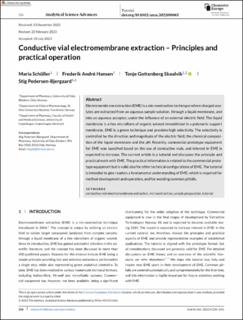| dc.contributor.author | Schüller, Maria | |
| dc.contributor.author | Hansen, Frederik Andre | |
| dc.contributor.author | Skaalvik, Tonje Gottenberg | |
| dc.contributor.author | Pedersen-Bjergaard, Stig | |
| dc.date.accessioned | 2024-03-07T12:35:37Z | |
| dc.date.available | 2024-03-07T12:35:37Z | |
| dc.date.created | 2023-08-07T12:37:21Z | |
| dc.date.issued | 2023 | |
| dc.identifier.citation | Analytical Science Advances (ASA). 2023, 4 (7-8), 236-243. | en_US |
| dc.identifier.issn | 2628-5452 | |
| dc.identifier.uri | https://hdl.handle.net/11250/3121433 | |
| dc.description.abstract | Electromembrane extraction (EME) is a microextraction technique where charged analytes are extracted from an aqueous sample solution, through a liquid membrane, and into an aqueous acceptor, under the influence of an external electric field. The liquid membrane is a few microliters of organic solvent immobilized in a polymeric support membrane. EME is a green technique and provides high selectivity. The selectivity is controlled by the direction and magnitude of the electric field, the chemical composition of the liquid membrane and the pH. Recently, commercial prototype equipment for EME was launched based on the use of conductive vials, and interest in EME is expected to increase. The current article is a tutorial and discusses the principle and practical work with EME. The practical information is related to the commercial prototype equipment but is valid also for other technical configurations of EME. The tutorial is intended to give readers a fundamental understanding of EME, which is required for method development and operation, and for avoiding common pitfalls. | en_US |
| dc.language.iso | eng | en_US |
| dc.publisher | Wiley-VCH | en_US |
| dc.rights | Navngivelse 4.0 Internasjonal | * |
| dc.rights.uri | http://creativecommons.org/licenses/by/4.0/deed.no | * |
| dc.title | Conductive vial electromembrane extraction – Principles and practical operation | en_US |
| dc.title.alternative | Conductive vial electromembrane extraction – Principles and practical operation | en_US |
| dc.type | Peer reviewed | en_US |
| dc.type | Journal article | en_US |
| dc.description.version | publishedVersion | en_US |
| dc.source.pagenumber | 236-243 | en_US |
| dc.source.volume | 4 | en_US |
| dc.source.journal | Analytical Science Advances (ASA) | en_US |
| dc.source.issue | 7-8 | en_US |
| dc.identifier.doi | 10.1002/ansa.202200065 | |
| dc.identifier.cristin | 2165247 | |
| cristin.ispublished | true | |
| cristin.fulltext | original | |
| cristin.qualitycode | 1 | |

